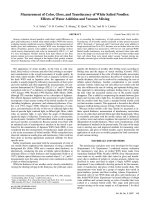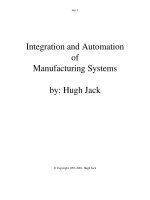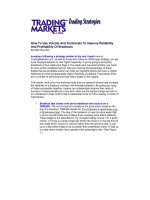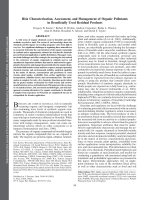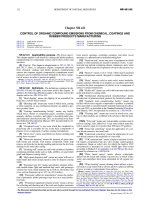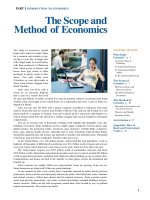Density and Viscosity of Water_4 pdf
Bạn đang xem bản rút gọn của tài liệu. Xem và tải ngay bản đầy đủ của tài liệu tại đây (4.44 MB, 397 trang )
JWBK117-FM JWBK117-Quevauviller October 18, 2006 10:42 Char Count= 0
Wastewater Quality
Monitoring and Treatment
i
Wastewater Quality Monitoring and Treatment Edited by P. Quevauviller, O. Thomas and A. van der Beken
C
2006 John Wiley & Sons, Ltd. ISBN: 0-471-49929-3
JWBK117-FM JWBK117-Quevauviller October 18, 2006 10:42 Char Count= 0
Water Quality Measurements Series
Series Editor
Philippe Quevauviller
European Commission, Brussels, Belgium
Published Titles in the Water Quality Measurements Series
Hydrological and Limnological Aspects of Lake Monitoring
Edited by Pertti Heinonen, Giuliano Ziglio and Andr´e van der Beken
Quality Assurance for Water Analysis
Authored by Philippe Quevauviller
Detection Methods for Algae, Protozoa and Helminths in Fresh and
Drinking Water
Edited by André van der Beken, Giuliano Ziglio and Franca Palumbo
Analytical Methods for DrinkingWater: Advances in Sampling and Analysis
Edited by Philippe Quevauviller and K. Clive Thompson
Biological Monitoring of Rivers: Applications and Perspectives
Edited by Giuliano Ziglio, Maurizio Siligardi and Giovanna Flaim
Wastewater Quality Monitoring and Treatment
Edited by Philippe Quevauviller, Olivier Thomas and André van der Beken
Forthcoming Titles in the Water Quality Measurements Series
Rapid Chemical and Biological Techniques for Water Monitoring
Edited by Philippe Quevauviller, Catherine Gonzalez and Richard Greenwood
ii
JWBK117-FM JWBK117-Quevauviller October 18, 2006 10:42 Char Count= 0
Wastewater Quality
Monitoring and Treatment
PHILIPPE QUEVAUVILLER
European Commission, DG Environment, Brussels, Belgium
OLIVIER THOMAS
Environment and Sustainable Development Institute,
University of Sherbrooke, Quebec, Canada
ANDR
´
E VAN DER BEKEN
Department of Hydrology and Hydraulic Engineering,
Free University of Brussels, Brussels, Belgium
iii
JWBK117-FM JWBK117-Quevauviller October 18, 2006 10:42 Char Count= 0
Copyright
C
2006 John Wiley & Sons Ltd, The Atrium, Southern Gate, Chichester,
West Sussex PO19 8SQ, England
Telephone (+44) 1243 779777
Email (for orders and customer service enquiries):
Visit our Home Page on www.wileyeurope.com or www.wiley.com
All Rights Reserved. No part of this publication may be reproduced, stored in a retrieval system or
transmitted in any form or by any means, electronic, mechanical, photocopying, recording, scanning or
otherwise, except under the terms of the Copyright, Designs and Patents Act 1988 or under the terms of a
licence issued by the Copyright Licensing Agency Ltd, 90 Tottenham Court Road, London W1T 4LP, UK,
without the permission in writing of the Publisher. Requests to the Publisher should be addressed to the
Permissions Department, John Wiley & Sons Ltd, The Atrium, Southern Gate, Chichester, West Sussex PO19
8SQ, England, or emailed to , or faxed to (+44) 1243 770620.
Designations used by companies to distinguish their products are often claimed as trademarks. All brand names
and product names used in this book are trade names, service marks, trademarks or registered trademarks
of their respective owners. The Publisher is not associated with any product or vendor mentioned
in this book.
This publication is designed to provide accurate and authoritative information in regard to the subject matter
covered. It is sold on the understanding that the Publisher is not engaged in rendering professional services. If
professional advice or other expert assistance is required, the services of a competent professional should be
sought.
Other Wiley Editorial Offices
John Wiley & Sons Inc., 111 River Street, Hoboken, NJ 07030, USA
Jossey-Bass, 989 Market Street, San Francisco, CA 94103-1741, USA
Wiley-VCH Verlag GmbH, Boschstr. 12, D-69469 Weinheim, Germany
John Wiley & Sons Australia Ltd, 42 McDougall Street, Milton, Queensland 4064, Australia
John Wiley & Sons (Asia) Pte Ltd, 2 Clementi Loop #02-01, Jin Xing Distripark, Singapore 129809
John Wiley & Sons Canada Ltd, 6045 Freemont Blvd, Mississauga, Ontario, L5R 4J3, Canada
Wiley also publishes its books in a variety of electronic formats. Some content that appears
in print may not be available in electronic books.
Library of Congress Cataloging-in-Publication Data
Wastewater quality monitoring and treatment / [edited by] Philippe Quevauviller, Olivier Thomas,
Andr´e van der Beken.
p. cm.
Includes bibliographical references and index.
ISBN-13: 978-0-471-49929-9
ISBN-10: 0-471-49929-3
1. Sewage – Purification – Quality control. 2. Water quality – Measurement.
3. Water quality management. I. Quevauviller, Ph. II. Thomas, Olivier. III. Beken, Andr´e van der.
TD745.W345 2006
628.1
68 – dc22 2006018012
British Library Cataloguing in Publication Data
A catalogue record for this book is available from the British Library
ISBN-10: 0-471-49929-3
ISBN-13: 978-0-471-49929-9
Typeset in 10.5/12.5pt Times New Roman by TechBooks, New Delhi, India
Printed and bound in Great Britain by TJ International Ltd, Padstow, Cornwall
This book is printed on acid-free paper responsibly manufactured from sustainable forestry
in which at least two trees are planted for each one used for paper production.
iv
JWBK117-FM JWBK117-Quevauviller October 18, 2006 10:42 Char Count= 0
Contents
Series Preface vii
Preface ix
List of Contributors xi
1.1 Wastewater Regulation 1
Violeta Vinceviciene
1.2 Sampling Assistance 23
Olivier Thomas
1.3 Standard Methodologies 35
Estelle Dupuit
1.4 Alternative Methods 53
Olivier Thomas
1.5 Biosensors and Biological Monitoring for Assessing
Water Quality 67
Carmen Rebollo, Juan Azc´arate and Yolanda Madrid
1.6 Reference Materials 83
Philippe Quevauviller, Christian Dietz and Carmen C´amara
2.1 Sewers (Characterization and Evolution of Sewage) 111
Olivier Thomas and Marie-Florence Pouet
2.2 Sewer Flow Measurement 119
Charles S. Melching
Wastewater Quality Monitoring and Treatment Edited by P. Quevauviller, O. Thomas and A. van der Beken
C
2006 John Wiley & Sons, Ltd
v
JWBK117-FM JWBK117-Quevauviller October 18, 2006 10:42 Char Count= 0
vi Contents
2.3 Monitoring in Rural Areas 145
Ann van Griensven and V´eronique Vandenberghe
3.1 Elements of Modelling and Control of Urban Wastewater
Treatment Systems 161
Olivier Potier and Marie-No¨elle Pons
3.2 Treatability Evaluation 179
Gianni Andreottola and Paola Foladori
3.3 Toxicity Evaluation 203
Martijn Devisscher, Chris Thoeye, Greet De Gueldre and Boudewijn Van
De Steene
3.4 Nutrient Control 219
Victor Cerd`a and Jos´e M. Estela
4.1 State Estimation for Wastewater Treatment Processes 247
Olivier Bernard, Benoˆıt Chachuat and Jean-Philippe Steyer
4.2 Industrial Wastewater Quality Monitoring 265
Olivier Thomas and Marie-Florence Pouet
5.1 Quality Survey of Wastewater Discharges 275
Marie-Florence Pouet, Genevi`eve Marcoux and Olivier Thomas
5.2 Monitoring for Water Quality Modelling 289
V´eronique Vandenberghe, Ann van Griensven and Peter Vanrolleghem
5.3 Discharges in Sensitive Receiving Waters 311
Giuliano Ziglio, Marco Vian and Claudia Lasagna
5.4 Water Reuse 329
Davide Bixio, Thomas Wintgens, Aldo Ravazzini, Chris Thoeye, Haim
Cikurel, Av Aharoni, Jaap De Koning and Thomas Melin
6.1 Collecting and Merging Data from Widespread and
Disparate Sources 351
Michael J. Scott
6.2 Training 377
Jean-Luc C´ecile and Evelyne Touraud
Index 385
JWBK117-FM JWBK117-Quevauviller October 18, 2006 10:42 Char Count= 0
Series Preface
Water is a fundamental constituent of life and is essential to a wide rangeofeconomic
activities. It is also a limited resource, as we are frequently reminded by the tragic
effects of drought in certain parts of the world. Even in areas with high precipitation,
and in major river basins, over-use and mismanagement of water have created severe
constraints on availability. Such problems are widespread and will be made more
acute by the accelerating demand on freshwater arising from trends in economic
development.
Despite the fact that water-resource management is essentially a local, river-
basin-based activity, there are a number of areas of action that are relevant to all or
significant parts of the European Union and for which it is advisable to pool efforts
for the purpose of understanding relevant phenomena (e.g. pollution, geochemical
studies), developing technical solutions and/or defining management procedures.
One of the keys for successful cooperation aimed at studying hydrology, water
monitoring, biological activities, etc., is to achieve and ensure good water quality
measurements.
Quality measurements are essential to demonstrate the comparability of data ob-
tained worldwideandthey form the basisforcorrect decisions relatedtomanagement
of water resources, monitoring issues, biological quality, etc. Besides the necessary
quality control tools developed for various types of physical, chemical and biologi-
cal measurements, there is a strong need for education and training related to water
quality measurements. This need has been recognized by the European Commission
which has funded a series of training courses on this topic, covering aspects such
as monitoring and measurements of lake recipients, measurements of heavy metals
and organic compounds in drinking and surface water, use of biotic indexes, and
methods to analyse algae, protozoa and helminths. In addition, series of research
and development projects have been or are being developed.
This book series will ensure a wide coverage of issues related to water quality
measurements, including the topics of the above-mentioned courses and the outcome
of recent scientific advances. In addition, other aspects related to quality control
tools (e.g. certified reference materials for the quality control of water analysis) and
Wastewater Quality Monitoring and Treatment Edited by P. Quevauviller, O. Thomas and A. van der Beken
C
2006 John Wiley & Sons, Ltd
vii
JWBK117-FM JWBK117-Quevauviller October 18, 2006 10:42 Char Count= 0
viii Series Preface
monitoring of various types of waters (river, wastewater, groundwater) will also be
considered.
This book Wastewater Quality Monitoring and Treatment is the sixth one of the
series; it has been written by experts in wastewater policy, treatment and analyti-
cal science and offers the reader an overview of existing knowledge and trends in
wastewater monitoring features.
The Series Editor – Philippe Quevauviller
JWBK117-FM JWBK117-Quevauviller October 18, 2006 10:42 Char Count= 0
Preface
The European Community decided in 1991 to obligate all the Member States to
be equipped with wastewater treatment plants for all the cities whose wastewater
organic loads are greater than 15 000 equivalent-inhabitants, before the 31
st
Decem-
ber 2000, and 2000 equivalent-inhabitants before the 31
st
December 2005. In this
context, the quality of the treated wastewater must be better than reference values for
some variables such as BOD (biological oxygen demand), COD (chemical oxygen
demand), TSS (total suspended solids), global nitrogen and total phosphorus. These
obligations generate a huge range of activities within the European Union, including
research and technological developments, and similar trends can be observed, e.g.
in the USA and Canada.
Unfortunately, wastewater monitoring procedures are prone to many drawbacks
because of difficulties to accurately and frequently measure the necessary variables,
which essentially rely on ‘classical’ monitoring approaches involving sampling, stor-
age and laboratory analysis. The only way to make progress in wastewater treatment
(and hence to comply with related regulations) is to ensure that the plants are able
to work with unqualified reliability which implies that reliable monitoring of the
wastewater quality and quantity and of the treatment efficiency should be performed
for the characterisation of raw and treated wastewaters and for the control of the
plant itself.
This book reflects this awareness by summarising different views on wastewater
treatment-related monitoring and control. The book is composed of six different
parts. The first part provides an overview of EU and US wastewater policies, stan-
dard methodologies, reference materials and discusses sampling assistance, biosen-
sors and alternative methods. Sewer quality control is examined in the second part,
including considerations on sewage characterisation and evolution, flow measure-
ments and monitoring in rural areas. This is followed, in the third part, by chapters
concerning urban wastewater treatment plant control and, in the fourth, by indus-
trial wastewater treatment plant control. Part 5 discusses monitoring in the context
of discharges and receiving medium, including water quality modelling. Finally,
Wastewater Quality Monitoring and Treatment Edited by P. Quevauviller, O. Thomas and A. van der Beken
C
2006 John Wiley & Sons, Ltd
ix
JWBK117-FM JWBK117-Quevauviller October 18, 2006 10:42 Char Count= 0
x Preface
socio-economic aspects are considered in the sixth part, with a focus on data collec-
tion and merging, as well as training.
This book has been written by experts in the field of wastewater treatment pol-
icy, control and monitoring. It provides an overview of the existing knowledge in
wastewater monitoring and identifies emerging needs, which will be of direct interest
to policy makers, water scientists and industries, and analytical control laboratories.
Philippe Quevauviller, Olivier Thomas and Andr´e van der Beken
JWBK117-FM JWBK117-Quevauviller October 18, 2006 10:42 Char Count= 0
List of Contributors
Av Aharoni MekorotLtd, 9Lincoln St,POBox20128,Tel-Aviv61201,
Israel
Gianni Andreottola Department of Civil and Environmental Engineering, Uni-
versity of Trento, Via Mesiano 77, 38050 Trento, Italy
Juan Azc´arate Ayuntamiento de Madrid, Departamento de Aguas y
Saneamiento, C/Barcel´o,61
◦
, 28004 Madrid, Spain
Olivier Bernard INRIA - Projet COMORE, BP93, 06902 Sophia-Antipolis
Cedex, France
Davide Bixio Aquafin NV, Dijkstraat 8, 2630 Aartselaar, Belgium
Carmen C´amara Departamento de Qu´ımica Anal´ıtica, Facultad de Ciencias
Qu´ımicas, Universidad Complutense de Madrid, Ciudad
Universitaria s/n, 28040 Madrid, Spain
Jean-Luc C´ecile Institut de R´egulation et d’Automation, 23 Chemin des
Moines, 13200 Arles, France
Victor Cerd`a Department of Chemistry, University of Balearic Is-
lands, Carretera de Valldemossa, km 7.5, 07122 Palma de
Mallorca, Spain
Benoˆıt Chachuat Ecole Polytechnique F´ed´erale de Lausanne, Laboratoire,
d’Automatique, Station 9, 1015 Lausanne, Switzerland
Haim Cikurel MekorotLtd, 9Lincoln St,POBox20128,Tel-Aviv61201,
Israel
Wastewater Quality Monitoring and Treatment Edited by P. Quevauviller, O. Thomas and A. van der Beken
C
2006 John Wiley & Sons, Ltd
xi
JWBK117-FM JWBK117-Quevauviller October 18, 2006 10:42 Char Count= 0
xii List of Contributors
Martijn Devissccher Dijkstraat 8, 2630 Aartselaar, Belgium
Christian Dietz Departamento de Qu´ımica Anal´ıtica, Facultad de Ciencias
Qu´ımicas, Universidad Complutense de Madrid, Ciudad
Universitaria s/n, 28040 Madrid, Spain
Estelle Dupuit 24 rue de Gerofosse, 91150 Etampes, France
Jos´e M. Estela Department of Chemistry, University of Balearic Is-
lands, Carretera de Valldemossa, km 7.5, 07122 Palma de
Mallorca, Spain
Paola Foladori Department of Civil and Environmental Engineering, Uni-
versity of Trento, Via Mesiano 77, 38050 Trento, Italy
Ann van Griensven BIOMATH, Ghent University, Coupure Links 653, 9000
Ghent, Belgium
Greet De Gueldre Aquafin NV, Dijkstraat 8, 2630 Aartselaar, Belgium
Jaap De Koning Delft University of Technology, Stevinweg 1, PO Box
5048, GA Delft 2600, The Netherlands
Claudia Lasagna AMGA S.p.A., via Piacenza 54, 16138, Genova, Italy
Yolanda Madrid Departamento de Qu´ımica Anal´ıtica, Facultad de Ciencias
Qu´ımicas, Universidad Complutense de Madrid, Ciudad
Universitaria s/n, 28040 Madrid, Spain
Genevi`eve Marcoux Civil Engineering Department, Sherbrooke University,
2500 bld de l’Universit´e, Sherbrooke, Quebec, J1K 2R1,
Canada
Charles S. Melching Department of Civil and Environmental Engineering,
Marquette University, PO Box 1881, Milwaukee, WI
53201-1881, USA
Thomas Melin RWTH Aachen University, Turmstrasse 46, Aachen
52056, Germany
Marie-No¨elle Pons Laboratoire des Sciences du Genie Chimique, LSGC -
CNRS-Groupe ENSIC,1 rue Grandville,BP 20451,54001
Nancy Cedex, France
JWBK117-FM JWBK117-Quevauviller October 18, 2006 10:42 Char Count= 0
List of Contributors xiii
Olivier Potier Laboratoire des Sciences du Genie Chimique, LSGC -
CNRS-Groupe ENSIC,1 rue Grandville,BP 20451,54001
Nancy Cedex, France
Marie-Florence Pouet Environment and Sustainable Development Institute,
Sherbrooke University, 2500 bld de l’Universit´e, Local
A6-1021, Sherbrooke, Quebec, J1K 2R1, Canada
Philippe Quevauviller European Commission, DG Environment (BU9 3/142),
Rue de la Loi 200, 1049, Brussels, Belgium
Aldo Ravazzini Delft University of Technology, Stevinweg 1, PO Box
5048, GA Delft 2600, The Netherlands
Carmen Rebollo Ayuntamiento de Madrid, Departamento de Aguas y
Saneamiento, C/Barcel´o,61
◦
, 28004 Madrid, Spain
Michael J. Scott Process Measurement Technology, 27 West Green, Bar-
rington, Cambridge CB2 SRZ, UK
Boudewijn Van De Aquafin NV, Dijkstraat 8, 2630 Aartselaar, Belgium
Steene
Jean-Philippe Steyer INRA, URO50, Laboratoire de Biotechnologie de
l’Environnement, Avenue des etangs, 11100 Narbonne,
France
Chris Thoeye Aquafin NV, Dijkstraat 8, 2630 Aartselaar, Belgium
Olivier Thomas Environment and Sustainable Development Institute,
Sherbrooke University, 2500 bld de l’Universit´e, Local
A6-1021, Sherbrooke, Quebec, J1K 2R1, Canada
Evelyne Touraud Ecole des Mines d’Al`es, 6 Avenue de clavi`eres, 30319
Al`es C`edex, France
V´eronique BIOMATH, Ghent University, Coupure Links 653, 9000
Vandenberghe Ghent, Belgium
Peter Vanrolleghem BIOMATH, Ghent University, Coupure Links 653, 9000
Ghent, Belgium
Marco Vian Department of Civil and Environmental Engineering, Uni-
versity of Trento, Via Mesiano 77, 38050 Trento, Italy
JWBK117-FM JWBK117-Quevauviller October 18, 2006 10:42 Char Count= 0
xiv List of Contributors
Violeta Vincevicienne European Commission, DE Environment (BU93/168),
Rue de la Loi 200, 1049 Brussels, Belgium
Thomas Wintgens RWTH Aachen University, Turmstrasse 46, Aachen
52056, Germany
Giuliano Ziglio Department of Civil and Environmental Engineering, Uni-
versity of Trento, Via Mesiano 77, 38050 Trento, Italy
JWBK117-1.1 JWBK117-Quevauviller October 10, 2006 20:7 Char Count= 0
1.1
Wastewater Regulation
Violeta Vinceviciene
1.1.1 Urban Wastewater Treatment Regulation in the European Union
1.1.1.1 Urban Wastewater Treatment Directive in the Context of European Union
Water Legislation
1.1.1.2 Main Aspects of Wastewater Treatment Directives
1.1.1.3 Other Related Legislation on Other Types of Wastewater Except Urban
1.1.1.4 Conclusions
1.1.2 Urban Wastewater Treatment Regulation in the United States
1.1.2.1 Introduction
1.1.2.2 Development of Urban Wastewater Treatment Regulations
1.1.2.3 Highlights of Federal Water Pollution Control Act (Clean Water Act)
1.1.2.4 Highlights of the National Pollutant Discharge Elimination System Within
the Clean Water Act
1.1.2.5 Conclusions
References
Disclaimer. The views expressed herein are those of the author and do not necessarily represent the views of
the European Commission.
Wastewater Quality Monitoring and Treatment Edited by P. Quevauviller, O. Thomas and A. van der Beken
C
2006 John Wiley & Sons, Ltd. ISBN: 0-471-49929-3
JWBK117-1.1 JWBK117-Quevauviller October 10, 2006 20:7 Char Count= 0
2 Wastewater Regulation
1.1.1 URBAN WASTEWATER TREATMENT
REGULATION IN THE EUROPEAN UNION
1.1.1.1 Urban Wastewater Treatment Directive in the Context of
European Union Water Legislation
European water policy began in the 1970s with the adoption of so-called Community
Environmental Action Programmes (EAPs) and legally binding legislation. The first
EAP covered the period 1973–1976, and the latest – the sixth EAP – covers the period
2001–2010 and has four priority areas: climate change; nature and biodiversity;
environment and health; and management of natural resources and waste. One out
of the eight actions set up in the EAP relates to sustainable use and quality of
water, where the measure to improve application of water legislation is underlined
(European Commission, 2002).
Parallel to the political programmes, three waves of the European Union (EU) wa-
ter legislation can be distinguished. The first wave of legislation used water quality-
oriented approach; the second covered review and update of regulations from the
first wave and addressed new legislation related to the emission-control approach.
The Urban Wastewater Treatment Directive (UWWTD) 91/271/EEC (European
Commission, 1991) and the Integrated Pollution Prevention and Control Directive
(IPPCD) 96/91/EC adopted during the second wave are mainly dealing with urban
and industrial wastewater (European Commission, 1996).
The third wave started with using integrated approach of those two, mutually
reinforcing each other. The integrated approach takes into account two aspects: li-
miting pollution at the source by setting emission limit values (or emission stan-
dards); and establishing water quality objectives (or quality standards) for water
bodies. This approach is in accordance with the principles established in the EU
Treaty: i.e. the precautionary principle, high level of environmental protection, prin-
ciple of preventive action and rectification of pollution at the source, polluter pays
principle and integration of environmentalprotectioninto other Community Policies.
The new EU policy area started with the adoption of the Water Framework Direc-
tive (WFD) 2000/60/EC (European Commission, 2000) with which the UWWTD is
closely linked. The implementation of the UWWTD forms the cornerstone part of
the programme of measures of WFD to be included in river basin management plans
with the objective to achieve good ecological status of surface waters by 2015. How-
ever, the UWWTD sets up only minimum requirements to achieve this objective.
More stringent measures than those prescribed in the UWWTD for urban waste-
water treatment may be required in some specific cases when having sensitive water
bodies or water bodies being at risk of becoming sensitive. One of the main problems
of surface water bodies is eutrophication, thus specific treatment requirements for
nitrogen and phosphorus removal shall be set up for urban wastewater discharges to
receiving waters.
JWBK117-1.1 JWBK117-Quevauviller October 10, 2006 20:7 Char Count= 0
Urban Wastewater Treatment Regulation in the European Union 3
1.1.1.2 Main Aspects of Wastewater Treatment Directives
Related Community legislation
The UWWTD 91/271/EECisthe main piece ofEUenvironmentallegislation dealing
with urban wastewater. IPPCD 96/91/EC sets up the provisions for wastewater from
certain large industrial sectors. Dangerous Substances Directive (DSD) 76/464/EEC
and daughter directives control discharges of wastewater containing certain danger-
ous substances (European Commission, 1976).
Community measures on emissions including water discharges on sector-oriented
approach included in the IPPCD 96/61/EC set up emission limit values for large
industrial installations of specific industrial sectors. However, water contamina-
tion depends on the quantity of discharges which may also stem from smaller
plants. The Directive requires fixing emission limit values in the individual per-
mits for installations that come under this Directive. Referring to the Directive the
pollutants covered are those ‘likely to be emitted from installation in significant
quantities, having regards to their nature and their potential to transfer pollution
from one medium to the other (water, air and land)’. Very important to fix emis-
sion limit values for 12 ‘main polluting substances’ listed in the Annex III of the
Directive.
The Directive 76/464/EEC fixed the framework conditions for discharges of dan-
gerous substances into waters. The Directive establishes two lists of substances and
groups of substances to be addressed: list I contains substances considered toxic,
persistent or bioaccumulative; list II other polluting substances, which have a dete-
rious effect on the aquatic environment and which depend on the characteristics and
location of the water into which they are discharged. The Directive requires all dis-
charges containing list I or list II substances to be authorized. The authorizations had
laid down emission limit values for these substances. Under the Directive emission
limit values and quality objectives were fixed for 17 substances, ‘taking into account
the best technical means available’. For the list II substances Member States have to
establish programmes in order to reduce water pollution, and set timetables for their
implementation. The programmes had to include quality objectives for water, and
individual authorizations had to be issued in such a way that these quality objectives
shall be respected.
Principles and requirements of Urban Wastewater Treatment Directive
The UWWTD concerns collection, treatment and discharge of urban wastewater
from agglomerations and aims to protect the environment from being adversely
affected by the disposal of insufficiently treated urban wastewater and discharges of
wastewater from food-processing industries.
JWBK117-1.1 JWBK117-Quevauviller October 10, 2006 20:7 Char Count= 0
4 Wastewater Regulation
The Directive applies: (a) to all agglomerations having the organic load of more
than 2000population equivalent (p.e.);
1
(b) toagglomerations withless than2000p.e.
having collecting systems in place; and (c) to food-processing industries having the
load of more than 4000 p.e. and discharging treated wastewater directly to receiving
waters.
The requirements for treatment level are defined depending on the agglomeration
size and type of receiving water body where treated wastewater is discharged.
Types of wastewater covered by the Directive are urban, domestic, and industrial
wastewater:
r
Urban wastewater means domestic wastewater or the mixture of domestic waste-
water with industrial wastewater and/or run-off rain water.
r
Domestic wastewater means wastewater from residential settlements and services
which originates predominantly from the human metabolism and from household
activities.
r
Industrial wastewater means any wastewater, which is discharged from premises
used for carrying on any trade or industry, other than domestic wastewater and
run-off rainwater.
Four main principal obligations are laid down in the directive: planning; regula-
tion; monitoring; and information and reporting.
The planning aspect requires:
r
To designate sensitive areas (sensitive water bodies) in accordance with three spe-
cific criteria, and to review their designation every 4 years; to identify relevant hy-
drologic catchment area of this sensitive area, and to ensure that all discharges from
agglomerations with more than 10 000 p.e. located in sensitive area and their catch-
ment shall have more stringent treatment (containing nutrients removal) in place.
Surface water body shall be designated as sensitive if it falls into one of the
following groups:
– it is eutrophic or in the nearest future may become eutrophic if protective action
is not taken;
– it is intended for abstraction of drinking water;
– where further treatment than secondary is necessary to fulfil other Council
Directives.
r
Less sensitiveareas(as an option)canalso be specified accordingto certain criteria.
1
According to Article 2(6) of the UWWTD, ‘1 p.e. means the organic biodegradable load having five day
biochemical oxygen demand (BOD5) of 60 g of oxygen per day’.
JWBK117-1.1 JWBK117-Quevauviller October 10, 2006 20:7 Char Count= 0
Urban Wastewater Treatment Regulation in the European Union 5
r
To establish a technical and financial programme for the implementation of the
Directive for construction of sewage networks and wastewater treatment plants
addressing treatment objectives within the deadlines set up by the Directive.
Regulation requires ensuring that:
r
All urban wastewater generated in agglomerations discharging into urban sewer
systems and treatment plants have prior regulation or specific authorization.
r
Industrial wastewater discharging into urban sewage networks is based on prior
regulation and/or specific authorization; pretreatment requirements, ensuring that:
(a) treatment plant operation and sludge treatment will not being impeded;
(b) it will be no adverse effect to the environment (including receiving waters); and
(c) safe disposal of sewage sludge.
r
Food-processing industries have prior regulation and/or specific authorization and
permit system.
r
All urban wastewater generated in agglomerations with more than 2000 p.e. are
supplied with collecting systems, and the capacity of those is such that it ensures to
collect all urban wastewater taking into account normal local climatic conditions
and seasonal variations.
r
National authorities are taking measures in relation to collecting systems to limit
pollution of receiving waters from storm water overflows under unusual situations,
such as heavy rain.
r
Wastewater treatment is provided for all these agglomerations, at the level of
treatment specified and within the required deadline:
– The basic rule for the level of treatment is secondary (i.e. biological) and more
stringent treatment in sensitive areas (i.e. with nutrient removal in particular and
other pollutant affecting the quality of specific use of the receiving water).
– For certain discharges in coastal waters treatment might be less stringent, i.e.
primary, under specific conditions and subject to agreement of the Commission.
– For agglomerations with population equivalent of less that 2000 but equipped
with collecting system, ‘appropriate treatment’ has to be provided, i.e. treat-
ment that ensures to meet the relevant quality objectives of the receiving
waters.
r
Technical requirements on design, construction, operation and maintenance for
wastewater treatment plants treating urban wastewater are maintained ensuring
adequate capacity of the plant and treatment of urban wastewater generated in
agglomeration taking into account normal local climatic conditions and seasonal
variations.
r
Environment is protected from adverse effects of the discharge of wastewater.
JWBK117-1.1 JWBK117-Quevauviller October 10, 2006 20:7 Char Count= 0
6 Wastewater Regulation
r
Environmentally and technically sound reuse or disposal of sewage sludge is sub-
ject to general rules, registration or authorization, and requirements of specific
inter-linked directives for agricultural reuse (86/278/EEC), incineration (89/429/
EEC and 89/369/EEC), and landfill (99/31/EC), are respected. The disposal of
sludge to surface waters is banned.
Monitoring requires ensuring that:
r
appropriate monitoring capacity of parameters to be monitored;
r
proper analysis of samples by using standard methods;
r
timely frequency of monitoring for:
– monitoring of discharges from urban wastewater treatment plants; and
– monitoring of waters receiving those discharges.
Information and reporting requires ensuring that:
r
Adequate cooperation and exchange of information with other member states in
cases where discharges of wastewater have a transboundary effect on water quality
of shared waters.
r
Adequate reporting procedure and databases for the requests from the Commission
for information on:
– transposition of the directive into national legislation, implementation pro-
grammes, situation reports on the disposal and reuse of urban wastewater and
sewage sludge;
– status of collecting systems, efficiency of treatment plants (i.e. treatment level
and monitoring results) and water quality of receiving waters;
– status of discharges from food-processing industry to surface waters.
r
That the public has access to relevant information and that relevant authorities of
member states every 2 years will publish status reports to the public on the status
of wastewater collection and treatment and disposal or reuse of sludge.
The Directive is based on a number of principles that have been laid down in
the Treaty of the European Union, such as precautionary, nondeterioration, sustai-
nable use of water resources, and principle of subsidiary. The implementation of
the Directive should not result in deterioration of the current level of environmental
protection offered by the member states. Furthermore, the level of protection may be
even stricter than the Directive requires in case there is a need to fight deterioration of
quality of receiving water bodies and to try to restore waters affected by wastewater
discharges.
JWBK117-1.1 JWBK117-Quevauviller October 10, 2006 20:7 Char Count= 0
Urban Wastewater Treatment Regulation in the European Union 7
Parameters and parametric values in the Urban Wastewater Treatment Directive
The Directive regulates the main conventional pollutants in treated wastewater
discharges from treatment plants.Theseare:total suspended solids, chemical oxygen
demand, biochemical oxygen demand, total nitrogen and total phosphorus. However,
other parameters shall also be considered especially when making the assessment of
receiving waters to designate sensitive areas and to achieve water quality objectives
of water bodies.
The Directive sets up emission limit values for the above-mentioned parameters
or by showing treatment efficiency (calculating it through incoming and outgoing
pollution load of each regulated parameter). Either the concentration of a pollutant
at the discharge point or the reduction rate of pollution load shall apply.
The Directive sets up a general requirement for:
r
Treated urban wastewater reuse to ensure that there will be no adverse effect to
the environment. However, there are no detailed regulations on treated wastewater
quality for the purposes of its reuse for various economic activities.
r
The usage of sewage sludge indicating that it shall bere-usedwhenever appropriate
having no adverse affect on the environment.
However, there are no precise provisions in this Directive on setting emission
limit values or quality standards to be achieved when having activities of the reuse
of these end-products from wastewater treatment process. These two aspects are
partly or indirectly regulated by the other EU pieces of legislation.
Sampling and monitoring
The Directive requires establishing a monitoring and inspection programme for
compliance assessment of discharges from urban wastewater treatment plants and
for assessing the amounts and composition of sludge.
The Directive defines minimum monitoring requirements for treated wastewater
by setting sampling frequency, which is dependent on the size of urban wastewater
treatment plant. The maximum number of noncomplying samples is also defined in
the Directive.
The Directive also defines the standard laboratory methods to be used for the
analysis of the samples.
Quality control and assurance
Member States have to ensure laboratory capacities, and laboratories must use the
methods specified in the Directive Annex I and to be subject to regular quality
JWBK117-1.1 JWBK117-Quevauviller October 10, 2006 20:7 Char Count= 0
8 Wastewater Regulation
control. Accreditation schemes for laboratories are the means of constantly ensuring
quality control. Quality control is restricted to the analytical laboratory methods to
be used for the analysis of samples. Member States need to have some quality control
system in place in the approved laboratories for wastewater analyses.
Taking into account the principle of subsidiary, Member States have a duty to
organize and self-control the Directive implementation by setting adequate urban
wastewater collectionsystemsand treatment facilitiesaswellas controlling wastewa-
ter pollution level through monitoring of urban wastewater against Directive require-
ments.
The control of annual monitoring results of treated urban wastewater is a duty of
Member States to check against the Directive requirements. The data shall be stored
in the Member State to analyse trends and impact of discharged wastewater to the
environment and to ensure the reporting of the results to the Commission to check
the implementation status. Member States have to provide requested data within the
deadline of 6 months.
1.1.1.3 Other Related Legislation on Other Types of
Wastewater Except Urban
Implementation of the main UWWT Directive is closely linked with other EU
legislation, in particular:
r
Water Framework Directive 2000/60/EC;
r
Nitrates Directive 91/676/EEC;
r
Integrated Pollution Prevention and Control Directive 96/91/EC;
r
Dangerous Substances Directive 76/464/EEC and its seven daughter directives;
r
Sewage Sludge Directive 86/278/EEC;
r
Landfill Directive 99/31/EC;
r
Incineration Directives 89/429/EEC and 89/369/EEC;
r
Environmental Impact Assessment Directive 85/337/EEC;
r
Directive on Access to Environmental Information 90/313/EEC;
r
Reporting Directive 91/692/EEC and Decision 94/741/EEC;
Particularly relevant issues in these directives concern:
r
The provisions under UWWTD are the integral part of basic measures in the
programme of measures to be included into river basin management plans under
JWBK117-1.1 JWBK117-Quevauviller October 10, 2006 20:7 Char Count= 0
Urban Wastewater Treatment Regulation in the European Union 9
WFD, without any change of deadlines set under UWWTD for the EU-15 and in
line with the transitional periods set up in the Accession Treaty for the EU-10.
r
The provision of adequate facilities for either incineration or landfill of sewage
sludge.
r
The quality requirements for sewage sludge used in agriculture.
r
Certain size large installations of food-processing industries covered by UWWTD
also fall under requirements of the IPPCD (i.e. for some installations the require-
ments of both directives overlap). It should be borne in mind that IPPC Directive
sets requirements for application of a combined approach (as the WFD does) of
emission controls and water quality standards. In each particular case the more
stringent approach (setting more stringent treatment standards for wastewater) to
reach certain water quality objectives applies.
Integration of EU water legislation does not only imply compliance to the require-
ments of various related directives but will alsoinvolve harmonization and streamlin-
ing of monitoring and reporting requirements. Reporting requirements will have to
address compliance and the state of, and trends in, the quality of aquatic environment
through implementing prevention measures – decrease generation of wastewater at
the source, sustainable management of water resources as well as when wastewater
is generated – ensuring the adequate required wastewater treatment. The process on
harmonization of reporting has been started with the concept and the ambitious goal
to have an integrated reporting system in Europe, the so-called Water Information
System for Europe (WISE).
1.1.1.4 Conclusions
It should be underlined that the implementation of the UWWTD ranks amongst the
most challenging and expensive tasks throughout the range of EU legislation. This
is why early and careful consideration of the environmental and technical aspects of
the Directive is of significant importance.
Much of the environmental legislation in the EU is interrelated, both within a spe-
cific sector (e.g. water sector) and between sectors. Consequently, individual Com-
munity legal acts cannot be implemented in isolation. For example, implementation
of UWWTD 91/271/EEC in advance of another directive can lead to environmental
problems, e.g. increased volumes of sewage sludge which then need to be disposed
of in accordance with Waste Framework Directive 75/442/EEC. Furthermore, the
main measures to implement the UWWTD are one of the main components of the
Programme of measures of River basin management plans required by the Water
Framework Directive. However, complete implementation of UWWTD is only a
minimum requirement to achieve good ecological status of surface waters required
by the WFD 2000/60/EC.
JWBK117-1.1 JWBK117-Quevauviller October 10, 2006 20:7 Char Count= 0
10 Wastewater Regulation
The EU regulation on urban wastewater treatment has contributed significantly to
the improvement and regulation of wastewater treatment and improvement of qual-
ity of discharges of wastewater into receiving waters and has contributed to fighting
the pollution at the source and the improvement of quality of surface waters. It is
expected that the underlying principles of the UWWTD will be further strengthened
and improved when implementing the WFD and by using an integrated approach.
Extending the control of wastewater discharges from end-of-pipe to using an in-
tegrated approach and meeting water quality standards and objectives to achieve
good ecological status of surface waters, boosts the confidence of European citizens
concerning the safety and wholesomeness of the use of surface waters for various
needs. Close cooperation between the European Commission and Member States is
a prerequisite to achieve this target.
1.1.2 URBAN WASTEWATER TREATMENT
REGULATION IN THE UNITED STATES
1.1.2.1 Introduction
The main regulatory basis to deal with water pollution control in the United States
is the Federal Water Pollution Control Act (FWPCA), known as the Clean Water
Act (CWA). It is a comprehensive statute aimed to restore and maintain chemical,
physical and biological integrity of the US waters. Enacted originally in 1948, theAct
was amended numerous times until it was reorganized and expanded in 1972. The
CWA is part of the US main legislation included in the Code of Federal Regulation
(CFR) on 18 October 1972 and forms Title 33 of this Code; it continues to be
amended almost every year (Deketelaer and Gekiere, 2002).
As authorized by the CWA, the National Pollutant Discharge Elimination System
(NPDES) permit programme controls water pollution by regulating point sources
that discharge pollutants into waters of the US. Since its introduction in 1972, the
NPDES permit programme has been responsible for significant improvements in
quality in the water bodies in the US ( />1.1.2.2 Development of Urban Wastewater Treatment Regulations
History of the Clean Water Act
The CWA is a law that establishes environmental programmes, including the
NPDES programme (introduced in 1972) to protect US waters and directs the
Environmental Protection Agency (EPA) to issue rules on how to implement this
law. The Act does not deal directly with ground water nor with water quantity issues.
The statute employs a variety of regulatory and nonregulatory tools to reduce direct
